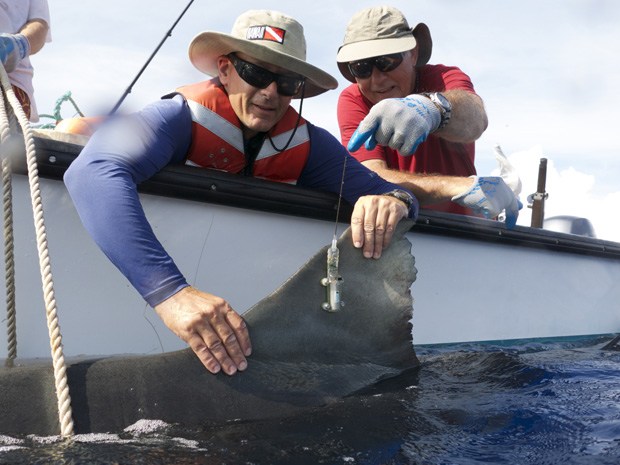Shark study helps explain higher incidence of encounters off Maui
 HIMB researchers Carl Meyer, left, and Kim Holland attach a tag to the dorsal fin of a tiger shark in Hawaiian waters. Image courtesy of HIMB.
HIMB researchers Carl Meyer, left, and Kim Holland attach a tag to the dorsal fin of a tiger shark in Hawaiian waters. Image courtesy of HIMB.Important research out of the University of Hawaiʻi is providing state leaders with critical information to better develop outreach and awareness efforts to minimize possibly dangerous encounters with tiger sharks. After a spike in shark bites off of Maui in 2012 and 2013, the State Department of Land and Natural Resources (DLNR) turned to the experts at the Hawaiʻi Institute of Marine Biology (HIMB). After years of work, HUMB shark researchers Carl Meyer and Kim Holland and a team of students completed an important study in 2016 revealing movement patterns of tiger sharks around Maui and Oʻahu.
“We tagged 41 tiger sharks off Maui and Oʻahu and tracked their movements for two years,” Meyer explains. “We found that these sharks spent most of their time over insular shelf habitats—this is the gently-sloping area between the shoreline and the shelf break at a depth of around 600 feet. These shelf habitats are home to a wide variety of tiger shark prey, and Maui Nui has more of this shelf habitat than all of the other Main Hawaiian Islands combined.”
The Pacific Islands Ocean Observing System (PacIOOS) makes tiger shark tracks available online and provides funding for ongoing tagging efforts.
Read more about it and watch the video reports at in the UH System News, Hawaii News Now, Hawaii Civil Beat, Maui News, and the DLNR press release; read more about it at WHDH.com and in the Christian Science Monitor.



